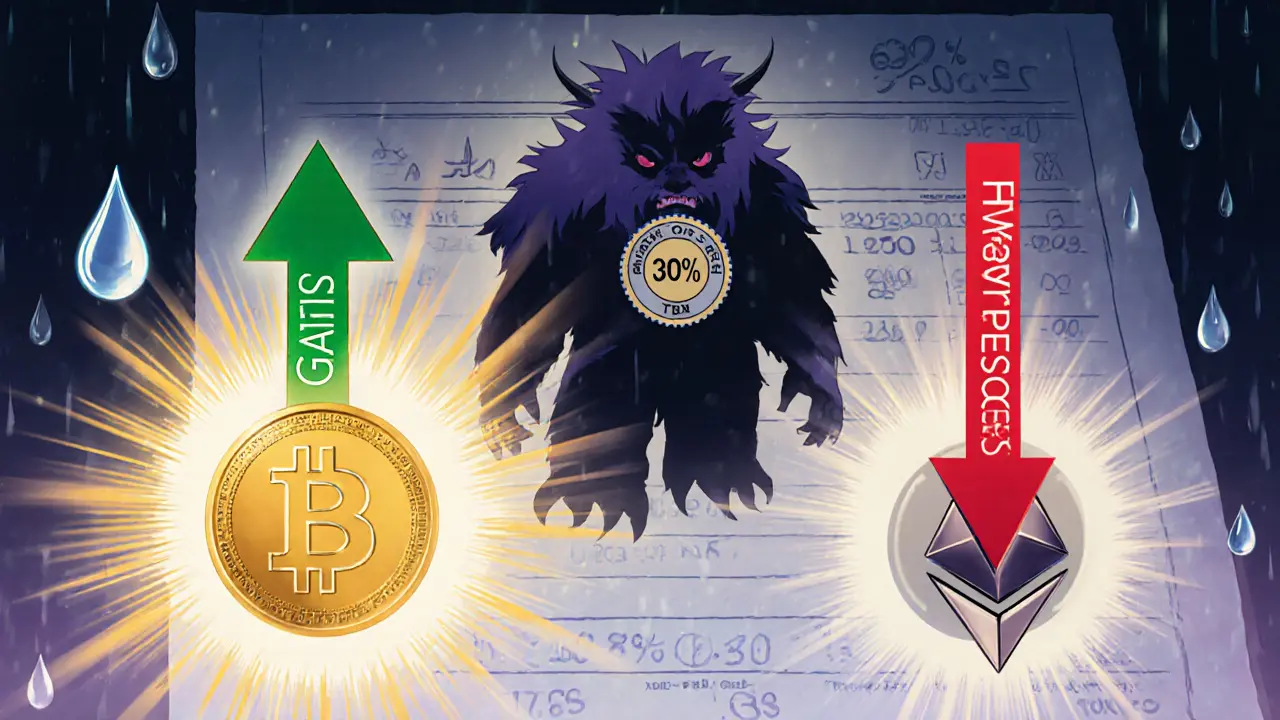Crypto Tax Calculator
This calculator helps you understand how India's no loss offset rule affects your crypto tax liability. Enter your gains and losses for different virtual digital assets (VDAs) below.
Tax Calculation Summary
Gross Gain: ₹
Loss: ₹
Taxable Gain (after no loss offset): ₹
Flat Tax (30%): ₹
TDS Deducted: ₹
Net Tax Payable: ₹
Net Cash Outflow: ₹
Effective Tax Rate: %
India’s no loss offset rule has turned crypto trading into a tax maze that many traders didn’t expect. If you’ve ever wondered why a profitable trade can still leave you with a net loss after taxes, the answer lies in a single provision of the Income Tax Act - Section 115BBH(2)(b). Below we break down what the rule actually does, how it reshapes your tax bill, and what practical steps you can take to stay compliant without emptying your wallet.
What the rule really says
At its core, the rule is simple but severe. Under Section 115BBH(2)(b) the law bars any loss incurred on Virtual Digital Assets (VDAs) from being set off against gains on other VDAs. In plain English: if you make ₹100,000 on Bitcoin and lose ₹80,000 on Ethereum in the same financial year, you still pay tax on the full ₹100,000 gain. The ₹80,000 loss never touches the tax calculation.
Key ingredients of India’s crypto tax framework
- 30% flat tax applies to all crypto gains, regardless of income slab or holding period.
- 1% Tax Deducted at Source (TDS) is levied on the gross value of each crypto transfer above ₹10,000 per year. Exchanges automatically deduct it, creating an immediate cash‑outflow.
- Schedule VDA is the mandatory reporting schedule that must be attached to ITR‑2 or ITR‑3 forms. Simpler ITR‑1 is off‑limits for anyone dealing in VDAs.
- Section 158B introduces a punitive 60% tax on undisclosed crypto holdings, applied retrospectively from 1Feb2025.
How the no‑loss offset rule changes your tax bill
Let’s run a quick example that mirrors the typical day‑to‑day experience of an active trader:
- Buy BTC for ₹200,000 and sell it later for ₹300,000 → Gain = ₹100,000.
- Buy ETH for ₹150,000 and sell it for ₹70,000 → Loss = ₹80,000.
- Apply the 30% flat tax on the ₹100,000 gain → Tax = ₹30,000.
- No offset for the ₹80,000 loss, so the net cash outflow is the tax plus any 1% TDS on each transaction.
Even though the overall profit before tax is only ₹20,000, the trader ends up paying ₹30,000 in tax - a net loss of ₹10,000. This asymmetry is the hallmark of the rule.
Why traditional loss‑offset mechanisms don’t work here
In equity markets, a loss in one stock can be set off against a gain in another, and any remaining loss can be carried forward for up to eight years. For businesses, non‑speculative losses can be offset against most other income streams. The crypto regime strips away all of those safety nets. Losses are dead‑ends; they cannot be carried forward, cannot reduce salary income, and cannot be used against future crypto gains. The result is a tax environment that looks like a one‑way street: you pay on the upswing, but the downswing gives you no relief.

Compliance checklist - what you must do today
| Task | When | Key Details |
|---|---|---|
| Maintain transaction ledger | Continuously | Record acquisition cost, sale value, date, and counterparties for every VDA move. |
| Pay 1% TDS | At each qualifying transfer | Exchange deducts automatically; peer‑to‑peer deals require manual deduction. |
| File Schedule VDA | By 31July (FY end) | Attach to ITR‑2/ITR‑3; ITR‑1 is not allowed. |
| Report acquisition cost only | During filing | Operational expenses like gas fees are non‑deductible. |
| Watch for Section 158B | Ongoing | Undisclosed holdings attract 60% tax + penalties. |
Skipping any of these steps can trigger penalties, interest, and in severe cases, prosecution for willful evasion.
Strategic ways to limit tax drag (without breaking the law)
- Focus on low‑turnover trades. The 1% TDS hurts high‑frequency activity more than occasional spot trades.
- Use crypto futures. Futures are classified as derivatives, not VDAs, so they escape the 30% flat tax and the TDS. However, P&L on futures is still taxable under business income rules.
- Consolidate gains. If you have multiple small gains, consider closing the books in a year where you have other taxable income, reducing the marginal impact of the 30% rate.
- Leverage tax‑dedicated services. Specialized firms can help generate accurate Schedule VDA entries and ensure no missed TDS deductions.
- Stay within the Liberalised Remittance Scheme (LRS) cap. Remitting more than ₹7lakh a year subjects you to a 20% Tax Collected at Source (TCS), adding another layer of cost.
None of these tactics remove the no‑loss offset rule, but they can keep cash flow tighter and prevent surprise tax bills.
Impact on the Indian crypto market
Data from major Indian exchanges show a steady dip in monthly trade volume since the rule’s rollout in 2022. Traders report moving to offshore platforms or shifting to derivative products. While offshore activity can boost personal returns, it also raises the risk of non‑compliance with the 60% undisclosed‑holding penalty. Moreover, the heavy tax burden discourages new entrants, slowing downstream innovation in DeFi, NFTs, and blockchain‑based startups.
What the future might hold
Budget 2025 kept the rule intact and added stricter penalties for non‑disclosure. Industry bodies are lobbying for a loss‑offset provision, arguing that the current model stifles investment and pushes activity underground. Until a legislative amendment arrives, the rule looks permanent. Traders should therefore treat it as a fixed cost of doing business in India and plan their strategies accordingly.
Frequently Asked Questions
Can I offset crypto losses against my salary?
No. The no‑loss offset rule bars any crypto loss from reducing salary or other non‑crypto income.
Do gas fees count as a deductible expense?
No. Indian law only allows the acquisition cost of the VDA to be deducted. Transaction fees, gas fees, and exchange commissions are not allowed.
Is the 1% TDS refundable if I end the year with a loss?
The TDS is a pre‑payment of tax. If your final tax liability is lower, you can claim a refund when filing your return.
Can I trade crypto futures to avoid the 30% tax?
Futures are treated as derivatives, so the 30% flat tax and the 1% TDS do not apply. However, profits from futures are taxable under business income at the applicable slab rate.
What happens if I fail to disclose crypto holdings?
Section 158B imposes a 60% tax on undisclosed holdings, plus penalties and possible prosecution for willful evasion.

Next steps for traders
1. Pull your transaction history from every exchange you use and load it into a spreadsheet or dedicated crypto tax tool.
2. Calculate total gains per VDA, apply the 30% flat rate, and add the 1% TDS already deducted.
3. File Schedule VDA with your ITR‑2/ITR‑3 before the deadline.
4. Consider shifting a portion of your activity to futures if you need to trade frequently.
5. Keep an eye on any legislative updates-if the government ever introduces a loss‑offset provision, you’ll want to be ready to adjust.
Understanding the no‑loss offset rule isn’t just about avoiding penalties; it’s about reshaping your trading game plan to survive in a high‑tax environment. Treat the rule as a fixed cost, plan around it, and you’ll keep more of what you earn.


Rob Watts
October 5, 2025 AT 09:14Tax on crypto in India feels like a punch in the gut.
Bhagwat Sen
October 8, 2025 AT 20:34India's no‑loss offset rule means you pay tax on every profit, even if you lose elsewhere. The 30% flat rate hits hard because there’s no way to reduce it with other crypto losses. Add the 1% TDS on each transfer and the cash outflow climbs even faster. Many traders end up with a net negative after filing.
Cathy Ruff
October 11, 2025 AT 18:01That explanation is half‑baked at best. The law flat‑out bans any offset, so you’re basically taxed on paper gains. Forget the fancy calculators – the rule is brutal. Everyone should be screaming about how it kills margin. The government just loves the revenue.
Amy Harrison
October 15, 2025 AT 05:21Wow, that breakdown really clears things up 😊. It’s crazy how the rule squeezes out any relief, but at least now we know where the pain points are 💡.
Miranda Co
October 17, 2025 AT 12:54You’re right the tax bite is huge. Keep a tight ledger and watch the TDS every time. That’s the only way to stay ahead.
Marc Addington
October 20, 2025 AT 10:21Our country can’t keep stifling innovators with such heavy taxes.
Natalie Rawley
October 22, 2025 AT 17:54Seriously, this is the worst tax nightmare ever crafted. The rule feels like a trap set by the finance department. No‑loss offset is a straight‑up robbery. Traders are fleeing offshore faster than you can say ‘crypto’. If this stays, the whole Indian ecosystem will crumble.
Alex Gatti
October 24, 2025 AT 19:54It’s wild how the rule pushes people to futures just to dodge the flat tax. I’ve seen traders switch overnight. The market dynamics are shifting fast.
John Corey Turner
October 26, 2025 AT 05:14Imagine a world where every crypto loss finally got a hug from the tax code. That’d be a playground for risk‑takers, not a battlefield. Instead, we’re left juggling numbers like circus act. The only silver lining is the rise of sophisticated tax tools. They might save a few bucks, but don’t expect miracles.
Katherine Sparks
October 27, 2025 AT 22:54In my experience, meticulous record‑keeping is paramount; any oversight can trigger penalties.
Even a tiny typo in Schedule VDA may invite scrutiny.
Eva Lee
October 29, 2025 AT 11:01Leveraging blockchain analytics platforms can streamline ledger reconciliation. Integrating API feeds reduces manual entry errors. Compliance teams should adopt these solutions ASAP.
Ciaran Byrne
October 30, 2025 AT 17:34Keep your transaction logs up to date.
It saves headaches later.
Brooklyn O'Neill
October 31, 2025 AT 18:34Absolutely, a tidy ledger makes the filing process painless.
It also helps spot discrepancies early.
Lurline Wiese
November 1, 2025 AT 16:47Ugh, the taxman’s grip is suffocating 😤. Every trade feels like a gamble against the system.
Jenise Williams-Green
November 2, 2025 AT 12:14The government's approach is almost immoral, targeting honest traders.
We should stand up and demand fairer legislation.
Until then, protect your assets wisely.
Adarsh Menon
November 3, 2025 AT 02:07The no‑loss offset rule is basically a tax trap designed to bleed traders dry. It forces you to pay 30 percent on every profit while ignoring any wound you’ve sustained. You end up paying more tax than you actually earned in a year. The 1% TDS is just the cherry on top of an already sour cake. If you think holding crypto is risky enough, add this fiscal nightmare to the mix. Many clever folks move to futures just to dodge the flat rate, but then they face business‑income tax anyway. The government proudly watches the revenue climb as traders scramble for loopholes. Every ledger entry becomes a battlefield, and every loss a dead‑end. You can’t carry forward the loss, you can’t offset against salary, you can’t even claim gas fees. The rule turns ordinary investors into tax‑avoidance acrobats. It also pushes the community towards offshore exchanges, which brings its own set of hazards. The moral of the story is simple: the tax code here loves to punish profit makers. If you’re smart, you’ll plan your trades around the rule and keep a meticulous spreadsheet. Otherwise, expect a net negative after the tax man takes his cut. So, brace yourself and treat the rule as an unavoidable cost of doing business.